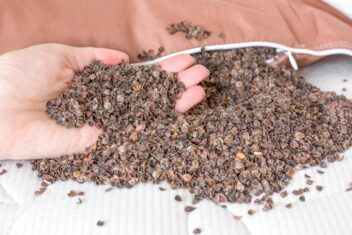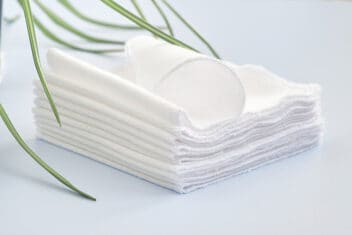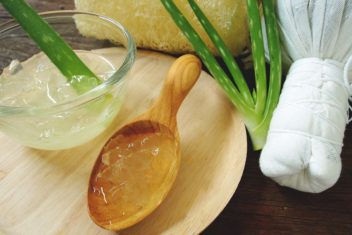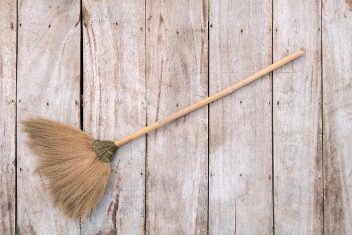Our bodies are in constant need of upkeep and repair, and pain is the body letting us know that something’s wrong. But what happens when a doctor (or dentist) isn’t immediately available?
If you live in a rural area and get a toothache in the middle of the night, you might not be able to just drive to a local ER.
Knowing some home remedies for toothaches can be invaluable for either dealing with temporary discomfort, or keeping you sane until you can get more treatment.
Determine Why You Have a Toothache
As an herbalist, I often get questions from people about what they should take for X issue. My response is invariably to ask what caused it. Like all other health concerns, the root cause of the pain/discomfort will determine its treatment.
Grab a flashlight and a mirror and take a good look inside your mouth. Examine the area where you’re experiencing pain, and see if you can figure out why you’re hurting.
Common toothache causes may include:
- A foreign object lodged between teeth or in the gum (bone chip from eating meat, poppy seed, etc.)
- Bruising or cuts
- Cavity
- A crack or chip
- Bruxism (tooth grinding, which usually happens at night and is caused by stress)
- Periodontal disease
- Dental decay (the tooth is falling apart or rotting)
- Hormone-related gingivitis (not often discussed, but erratic estrogen levels due to menstruation, pregnancy, peri/menopause, and hormone replacement therapy can cause gum inflammation and tooth shifting—both of which may be quite painful)
- Teething (this includes wisdom teeth coming in during one’s teens or twenties)
- An abscess
When and if there’s a foreign object present, try to remove it with tweezers or dental floss. If there isn’t anything obviously visible, inspect the area for redness, discoloration, swelling, or anything oozing. If there’s no crack or breakage visible, then the ache is likely from a mild inflammation or infection.
Home Remedies to Alleviate Pain and Swelling
Generally, the reason why we feel pain in or around our teeth is that there’s inflammation. This usually involves swelling, which can put pressure on the nerves around our teeth and gums. By alleviating this inflammation (while also numbing or cooling the area), we lessen the pain as well.
Below are some of the most common and easy home remedies for toothaches. You may have some of these ingredients in your pantry or medicine cabinet already, while the others are easy to find at health food stores or online herb shops.
1. Paracress

Spilanthes is a plant genus that has a rather extraordinary medicinal effect: it numbs areas that it’s applied to.
If you grow it yourself, you just need to pluck one of the blossoms and chew on it to experience its numbing, pain-relieving effect. I prefer to use the tincture as a poultice because there’s less chance of flower particles getting into already inflamed tissues.
I’ve never been able to grow this plant successfully, so I buy pre-made tinctures.
Take a piece of gauze and saturate it with paracress tincture. Then press it against the affected area and hold it there for at least 30 seconds.
Those who are pregnant or nursing should not use paracress. Additionally, those who are allergic to other members of the daisy (Asteraceae) family should avoid it as well. If you’ve ever had a bad reaction to chamomile or echinacea, avoid toothache cress.
2. Clove Oil

Cloves (Syzygium aromaticum) contain a compound called eugenol, which is both anti-inflammatory and antiseptic. Additionally, studies show that it has analgesic effects comparable to aspirin! Clove has been used to treat toothaches for thousands of years and is a great addition to your home apothecary cabinet.
To use this oil, mix three drops into a teaspoon of olive or coconut oil. Then use a fingertip to spread this mixture around the affected area. If the pain is on the outside of your tooth or gum, you can also saturate a cotton ball with this oil and pack it between your tooth and lip.
3. Bee Balm

Like other members of the mint (Lamiaceae) family such as thyme and oregano, bee balm (Monarda spp.) contains high amounts of thymol. This compound has anti-inflammatory, antibacterial, and anti-microbial properties, making it ideal for fighting infection.
It also has a cooling, numbing effect, which is great for alleviating pain while also treating the cause of the toothache.
There are two ways of using bee balm for dental pain: as an infused oil, or in tincture form. If you’re using infused oil, then you can apply it directly to the area or use a saturated cotton ball as mentioned above. For a tincture, saturate a cotton ball or a wedge of gauze, and hold it in place until the pain eases.
Either way, bee balm is a multi-purpose and one of the most effective home remedies for toothaches.
4. Myrrh Oil
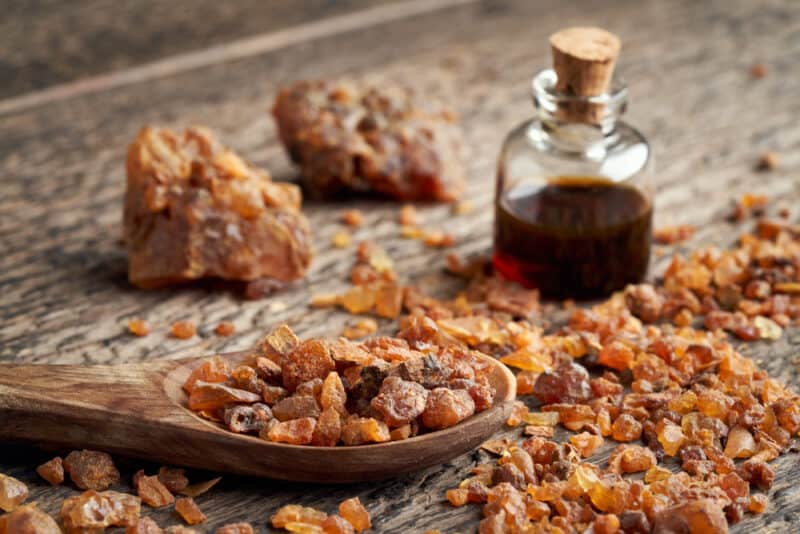
Like clove, myrrh (Commiphora spp.) has been used to alleviate dental pain and inflammation for centuries. Not only does myrrh have analgesic (painkilling) and anti-inflammatory effects, but it’s also antiseptic and antifungal.
Use it in the same way you would clove oil.
5. Thyme

As you may have guessed, common household thyme (Thymus vulgaris) is also a great source of thymol. It’s so effective for oral health care that it’s the primary ingredient in Euthymol toothpaste!
Use thyme oil the same way as clove, myrrh, or monarda.
6. Tea Tree Oil
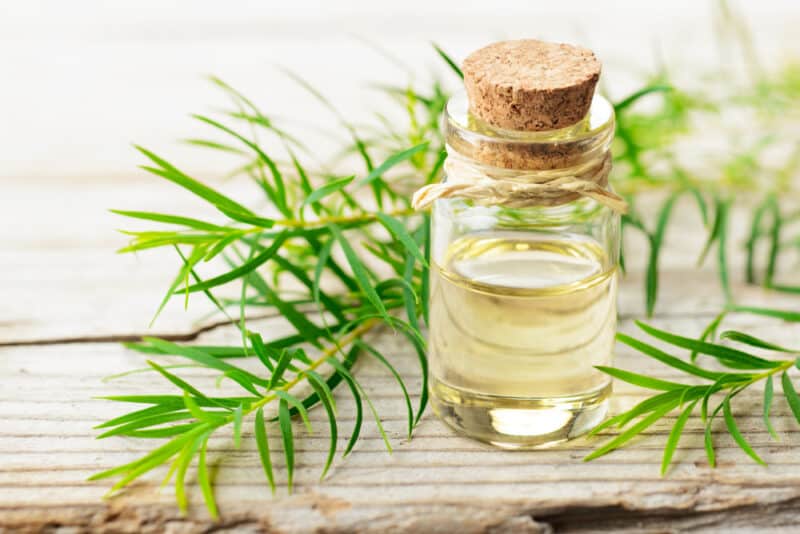
The funky-smelling oil from the tea tree (Melaleuca alternifolia) is startlingly beneficial for toothaches. Its antimicrobial, antiseptic, and anti-inflammatory effects can often sort out the cause of one’s pain, while also numbing the area.
Tea tree is remarkably effective for treating gingivitis, and can also blast away bacteria such as Streptococcus and Fusobacterium.
Use this oil the same way you would clove oil. Alternatively, you can also add five to 10 drops to half a cup of water and slosh it around your mouth like a gargle.
7. Peppermint Oil
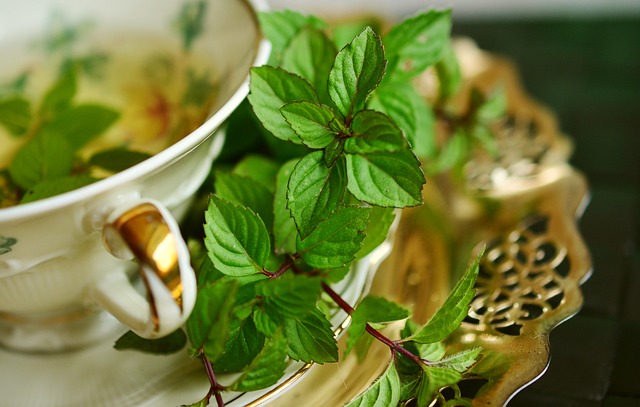
Mentha spicata x piperita has a cooling, analgesic effect that can provide almost instant relief for many different types of oral pain and inflammation. In addition to alleviating toothaches, it can also ease discomfort from canker sores, cuts, and sore throats.
Peppermint also has an antinociceptive effect, which (in simplest terms) means that it blocks pain receptors. A study by Yousef A. Taher at the University of Triipoli found that peppermint had a significant pain-blocking effect in mice.
As you can imagine, this is incredibly helpful when dealing with a persistent toothache!
Use 2 drops of peppermint oil in 1 tsp carrier oil. Alternatively, you can soak peppermint tea bags in warm (not hot!) water and pack them around the affected area.
8. Asafoetida

If you don’t cook a lot of Middle Eastern or Indian food, you may not have encountered asafoetida before. This spice is the dried latex from various Ferula species, which are indigenous to Iran and Afghanistan. It’s antibacterial, antimicrobial, anti-inflammatory, and antifungal, and can thus alleviate many issues contributing to dental pain.
Mix 1/2 teaspoon of asafoetida powder with just enough lemon juice to form a paste. Then pack that around the infected area. Leave for 20-30 minutes, and rinse your mouth out with warm water.
9. Hydrogen Peroxide

If you’re not the herby type, you may not have the aforementioned plantstuff around your home. That said, just about everyone has a bottle of peroxide in the medicine cabinet.
Since many toothaches are caused by infection or inflammation, peroxide can do a world of good. Simply mix equal parts peroxide and room-temperature water in a glass. Then slosh that around your mouth for about 30 seconds. Don’t swallow it!
Once you’re done, spit it out into the sink and then rinse your mouth with warm water.
If you’re experiencing a toothache because of a broken tooth, exposed nerve, or a crown that has fallen off, don’t use peroxide. It can irritate exposed nerves and make the pain worse.
10. Salt Water

A saltwater rinse can alleviate toothache pain significantly. This is one of the cheapest and easiest home remedies for toothaches, and also one of the most readily available.
Stir 1 tsp of salt into a cup of warm water until it dissolves. Then slosh it around your mouth, concentrating on the area that’s causing you pain. Continue sloshing for a few minutes, then spit it out, and rinse with warm water.
Know When to See Your Doctor
These home remedies for toothaches may eliminate toothache pain entirely, depending on what’s causing it. Alternatively, they might help to ease the pain and inflammation until you can book a dental appointment.
If you have a broken tooth with exposed nerves, however, try to get to a hospital to get that sorted out asap.
As always, remember to do your research before using any type of home remedy to treat a health concern. It’s your responsibility to determine whether you may have an unpleasant reaction to anything due to allergies or contraindications. When in doubt, consult with a herbalist or naturopath before trying anything.
Additionally, ask your healthcare provider if there are any home remedies for toothaches you should avoid. What works for one person may damage another, and vice versa.
Remember that an ounce of prevention is worth a pound of cure. Floss regularly if you don’t already do so, and brush your teeth gently with fluoride-free, natural toothpaste to avoid plaque buildup. You can also make your own mouthwash to reduce bacteria, and to treat inflammation in its early stages.
References:
- Shourie V, Dwarakanath CD, Prashanth GV, Alampalli RV, Padmanabhan S, Bali S. The effect of menstrual cycle on periodontal health – a clinical and microbiological study. Oral Health Prev Dent. 2012;10(2):185-92. PMID: 22763599.
- Marchese A, Barbieri R, Coppo E, Orhan IE, Daglia M, Nabavi SF, Izadi M, Abdollahi M, Nabavi SM, Ajami M. Antimicrobial activity of eugenol and essential oils containing eugenol: A mechanistic viewpoint. Crit Rev Microbiol. 2017 Nov;43(6):668-689. doi: 10.1080/1040841X.2017.1295225. Epub 2017 Mar 27. PMID: 28346030.
- Taher YA, Samud AM, El-Taher FE, ben-Hussin G, Elmezogi JS, Al-Mehdawi BF, Salem HA. Experimental evaluation of anti-inflammatory, antinociceptive and antipyretic activities of clove oil in mice. Libyan J Med. 2015 Sep 1;10(1):28685. doi: 10.3402/ljm.v10.28685. PMID: 26333873; PMCID: PMC4558274.
- Taher YA. Antinociceptive activity of Mentha piperita leaf aqueous extract in mice. Libyan J Med. 2012;7. doi: 10.3402/ljm.v7i0.16205. Epub 2012 Mar 27. PMID: 22468149; PMCID: PMC3316159.



